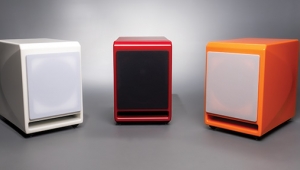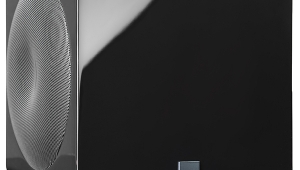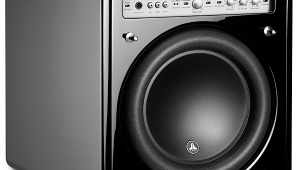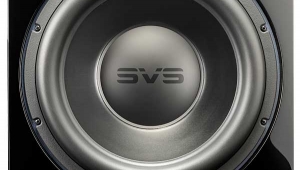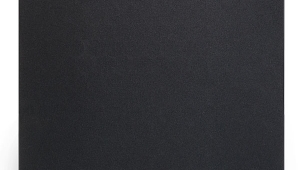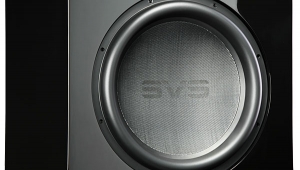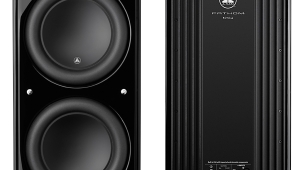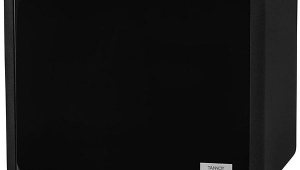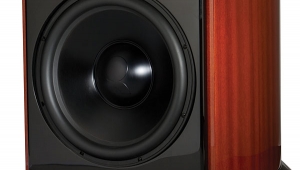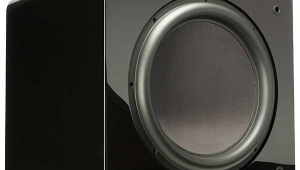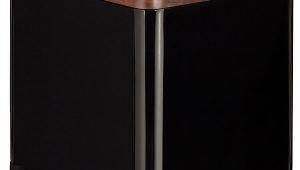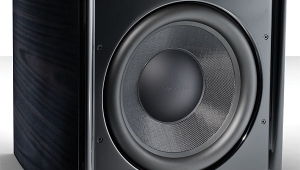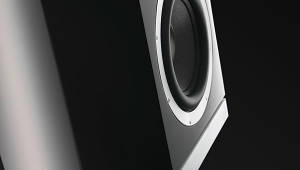| Columns Retired Columns & Blogs |
Muse Model 18 subwoofer Larry Greenhill
Larry Greenhill wrote about the Muse 18 in March 1993 (Vol.16 No.3):
Footnote 1: Thanks to Muse's Kevin Halverson for the loan of a Muse Model 18. This allowed me to compare it with the F-1500 and provide a "Follow-Up" at the same time. In the course of events, Kevin modified the Personality Card for the Quads. The standard Personality Card (#6A) for the Quad ESL-63s had been designed with the Quads sitting right on the floor. This is not an optimal position for these speakers, for it boosts their upper-bass bloom and subjects the sound to major floor-bounce effects.
Both Robert Harley and Corey Greenberg had raved about the Muse Model 18, a slot-loaded mono active subwoofer. Small plug-in circuit boards ("Personality Cards") allow the Muse to be customized to different satellite loudspeakers. This customization, and the Muse's very restricted frequency response (17Hz–100Hz), allow it to play with dynamic agility and a lack of plodding slowness. The Muse has become one of this magazine's top-rated subwoofers at a price competitive with the Velodyne ULD-18 and somewhat less imposing than the cost-no-object, twin-tower, 10-driver, active Kinergetics SW-800 ($4995).
But neither RH nor CG auditioned the Muse with electrostatic or planar speakers. This is critical, for electrostatics can be very revealing of problems upstream in the system; any veiling added by a subwoofer's crossover will be instantly revealed as a loss of transparency, soundstage collapse, or a disturbance in imaging. For this review, the Muse 18 used a specially modified Personality Card that accounted for the Quads being 18" off the floor (footnote 1).
The Quads, left sitting atop the SW-63 Gradient subwoofer cabinets to keep the electrostatic screens the correct height to avoid floor-bounce effects, were positioned 26" from the back wall and 72" apart. Other sessions had the Quads placed on Arcici stands at the same height. The F-1500, ULD-18, and Muse 18 were positioned in turn between the Quad screens at each subwoofer cabinet's front-to-back midpoint.
The two Velodyne subwoofers, the ULD-18 and ULD-15, and the Muse 18—were alternately run with the Quad ESL-63s and pairs of Sonus Faber Minima and B&W 805 minimonitors.
I set the bass level controls on the subwoofer crossovers by ear, using "Quidado" from Joe Beck's The Journey (DMP CD-481). Set too high, both the F-1500 and the ULD-18 tended to "boom" and thicken the overall sound. Excesses of Quad/Gradient bass led to a swollen, overbearing sound without pitch definition. The Muse 18, on the other hand, retained its very accurate pitch definition, just increasing its volume as the level control was advanced; however, this upset the tonal balance between screens and subwoofer, the net effect being to draw attention to the large cube sitting between the Quads. Turning down the level control re-integrated the sound to the point that there was no sense of the subwoofer contributing any sound of its own. In this regard, the dipole Quad/Gradient woofers had no advantage over any of the omnidirectional subwoofer designs.
For the dynamic minimonitors, the Quads were moved into another room, and the Minimas and B&W 805s were placed in the Quads' positions using sand-filled Sumiko Franklin & Lowell stands. The Muse was played without the Quad Personality Card for these speakers, of course.
Listening tests
The listening sessions in my original Velodyne ULD-18 review were designed to test for seven criteria, also applied to the F-1500 and the comparison subwoofers: 1) Did any of these subwoofers, including the F-1500, meet Dick Olsher's criteria of bass quantity (level) and extension (going to 20Hz)? 2) Which subwoofers integrated smoothly and seamlessly with the Quad ESL-63s? 3) How did the resulting subwoofer-satellite system handle overload during powerful bass notes? 4) Did any of the subwoofers' speeds match the Quad's? 5) Did the subwoofers extend the dynamic range of the Quads? 6) How did the new combination system sound when playing full-range pipe-organ music? and 7) Did the subwoofers' crossovers color the sonics of the main or satellite speakers?
1) Bass power and extension: First, all the subwoofers were compared in terms of low-frequency extension: the Muse excelled in bass quality, the Velodynes in bass quantity. As far as simple bass extension, my signal generator showed the Muse and both Velodynes reaching below 20Hz, shaking objects in the room at as low as 17Hz. The Muse went the deepest, continuing to rattle loose objects until the signal generator was tuned below 15Hz! No audible higher-frequency distortion products were heard. As far as bass quantity, both the Velodyne F-1500 and ULD-18 produced the most. Both put a tight bass "lock" on the room when a sustained organ-pedal note was played, such as in Jean Guillou's transcription of Mussorgsky's Pictures at an Exhibition (Dorian DOR-90117). The 32' pedal notes in the "Promenade" section were heard and felt, particularly with the F-1500 and ULD-18. Because the ULD-18 played this deep bass the loudest, it would be a good choice for a very large listening room. The Muse 18 played more softly, but with more defined musical pitch.
The Velodyne F-1500 moved a great deal of air, with ample slam and punch. It was faster in the deep bass than the Muse when connected to the Quad ESL-63s. On the other hand, the Muse 18 produced cleaner deep-bass notes, had better pitch definition, and provided the best resolution of detail in the deepest bass. As a system, the Muse was most resistant to muddying the signal when the level control was set too high.
2) System Integration: Here the Gradient SW-63s had a big advantage over the other subwoofers—they are designed just for Quad ESL-63s! In contrast, the conventional subwoofers veiled the midrange, decreasing the Quads' overall clarity.
3) Overload: But—and this is a big "but"—the SW-63s were very vulnerable to overload...Over the Muse 18 and the F-1500, the Chaconne played into my large listening room with no overload—just power, impact, and all the fury Holst intended that bass drum to deliver. The Muse and the Velodyne F-1500 and ULD-18 relieve the Quads, the Sonus Fabers, and the B&W 805s of any deep-bass excursions, these satellites tolerating the bass-drum percussion notes without clipping or overloading.
4) Speed: Closely related to system integration is subwoofer speed. Drumstrokes provided an excellent test of the subwoofer's slam, snap, and punch, all of which are associated with their speed and dynamic range. The onset of the drumstroke pulse can be sudden and startling, particularly when a subwoofer is supporting electrostatic screens, by nature some of the fastest drivers available....Although both the Muse and Velodyne ULD-18 fire downward, only the Velodyne made my floor flex during bass-drum strokes. This abrupt fortissimo drumhead WHAAACK was delivered with a clean, well-defined leading edge and gentle decay.
The Muse 18 seemed just as fast as the two moving-coil minimonitors, producing a seamless sonic field. But not so with the Quads: the Muse's deep-bass notes did not start or stop as quickly. While the Muse was best in pitch accuracy, it did not have the Velodynes' punch or slam. For example, it could not match the Velodynes' heart-stopping impact and hair-raising suddenness in reproducing the Synclavier II's explosive opening to "Ascent" (Time Warp, Telarc CD-80106). The Muse produced the same note with extremely clear pitch, but more softly and rounded, with less slam. Is this exciting bass shock just an effect, and not true music? Each listener must decide for himself.
5) Dynamic Range: The Muse 18 and F-1500 extended the dynamic ranges of the Quads and the moving-coil minimonitors. The Krell KBL preamp's volume control could be cranked higher, which formerly would have guaranteed Quad shutdown. The Quad ESL-63, though very low in distortion and very fast, tends to be dry and analytic on orchestral music. As CG noted with his Spica Angelus system, the bi-amplified Muse 18 subwoofer permitted satellite loudspeakers to play louder than ever before.
The subwoofer unburdened the main speakers and their amplifiers. The aggressive-sounding Quads played very loud, even though driven by a moderate-powered Mark Levinson No.27 amplifier playing within the speakers' drive voltage limits. The same increase in dynamics permitted minimonitors and electrostatics to play rock satisfyingly. Terry Bozzio's kickdrum and Tony Hymas's synthesizer came alive when given subwoofer dynamic-range extension, as heard on Jeff Beck's "Behind the Veil" (Jeff Beck's Guitar Shop, Epic EK 44313). The rimshots, kickdrum, and drumhead sounds became more explosive while being clearly defined, even though they weren't in the subwoofer's main frequency range.
6) Pipe Organ: The Velodynes and the Muse made it possible to enjoy pipe-organ music through such bass-shy speakers as Quads or Minimas. This is good; I find live pipe-organ music just awesome. I love the contrast between the purity and song of the upper flute stops and the pedals' shuddering solidity. The Gradient SW-63s, with their limited response below 40Hz, could not move air or couple with the room. But the two Velodynes and the Muse did.
Jean Guillou's organ transcription of Mussorgsky's Pictures (Dorian DOR-90117) is a good example. During the opening cut, the F-1500 reproduced the Great Kleuker-Steinmeyer organ of the Zörich Tonhalle with power and speed, shaking the room without losing the wonderful clarity of the instrument's flute and trumpet stops. The Muse did better than the Velodyne F-1500 in bringing out the fullness and air of the 32' pedal notes, retaining their pitch and distinction as separate notes, but could not equal the ultimate power of the smaller F-1500. The Muse, however, best delineated Scott's pipe organ from the orchestra and chorus in the Credo of Jan;aacek's Glagolitic Mass (Tilson Thomas, London Symphony Orchestra, Sony SK 47182).
I tested deep-bass extension and power with the 32Hz organ note about 31/2 minutes into the opening of Also Sprach Zarathustra (Time Warp, Telarc CD-80186). While the F-1500 was again clearly more powerful, the Muse had the clearest tone, allowing me to hear minor changes that seemed musically appropriate. Pitch, definition, and sonic accuracy are needed, not punch or speed; here the Muse performed beautifully.
7) Coloration of Upper Bass & Midrange: Despite its other strengths, the F-1500 was the most vulnerable to coloration effects in the midrange and upper bass....The F-1500's crossover, despite its use of passive components, was more colored than the Muse's, particularly when the Muse used the latest ESL-63 Personality Card (#20A).—Larry Greenhill
Footnote 1: Thanks to Muse's Kevin Halverson for the loan of a Muse Model 18. This allowed me to compare it with the F-1500 and provide a "Follow-Up" at the same time. In the course of events, Kevin modified the Personality Card for the Quads. The standard Personality Card (#6A) for the Quad ESL-63s had been designed with the Quads sitting right on the floor. This is not an optimal position for these speakers, for it boosts their upper-bass bloom and subjects the sound to major floor-bounce effects.
Footnote 2: Murphy's Law No.222: Your system will self-destruct when your editor comes to listen.
- Log in or register to post comments
